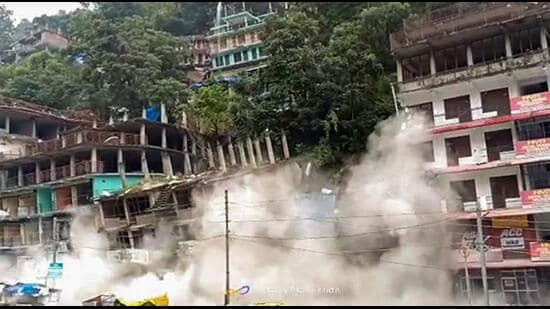The soil in parts of Himachal and Uttarakhand is almost sinking and causing devastation in the geologically sensitive regions.
In the second week of August, the monsoon trough moved north of its normal position to the Himalayan foothills, triggering heavy rainfall, landslides, and flash floods that damaged buildings, bridges, roads, and other infrastructure in the hill states of Himachal Pradesh and Uttarakhand
An interaction between a western disturbance and the trough also led to extremely heavy rainfall in the region and caused widespread damage in July. On August 18 and 19, the trough temporarily moved southward before moving to the north of its normal position again. Whenever it shifts north, rainfall is concentrated over the Himalayan states and northeast India while the rest of the plains remain largely dry.
Continuous rainfall soaks the topsoil, leading to flash floods, heavy erosion, and collapse of structures. The soil in parts of Himachal and Uttarakhand is almost sinking. And causing devastation in the geologically sensitive regions. Continued rainfall can saturate already withered topsoil and lead to small and large landslides and destruction particularly when infrastructure is not scientifically planned.
Wadia Institute of Himalayan Geology (Dehradun) director Kalachand Sain called for the need to understand why this is happening. “The monsoon trough is very active over the Himalayas. There is often also a confluence or interaction with westerly disturbances which accentuates rainfall. Due to climate change, some high-altitude regions are recording significant rises in temperatures and hence a rise in the water-vapour holding capacity. There is a lot of moisture available.”
Sain said in the Himalayan slope regions, the top part of the soil is environmentally weathered in most parts. “Very warm temperatures followed by cold temperatures—a cycle of thawing and freezing—is further degrading the topsoil. …there is a lot of anthropogenic activity which can further put these regions at risk such as hill cutting, slope instability, heavy load, etc in areas where load bearing capacity is not assessed.”
Sain called for sensitizing people about the risks in this terrain in current climatic conditions. “For short-term economic gain, lives can be lost if norms are not followed.”
Sain said all kinds of anthropogenic activities cannot be allowed in the Himalayan region. “This should be clear to people. Second, we can develop a landslide vulnerability map to identify zones at the highest risk…land use maps should be prepared for them. Land use can allow only those structures which are safe.”
Sain underlined the Himalayas are a very young mountain range and a lot of subsurface and surface activities were going on there. “There is erosion going on due to heavy rainfall events and snowfall. There is exhumation of rocks and plate tectonics. It is geo-dynamically extremely active due to these ongoing processes.”
He said the Himalayas are geologically very active and add to the risk. Sain cited the downstream impact on the national Capital when continuous rainfall led to devastating floods, landslides, and mudslides in Himachal Pradesh followed by Uttarakhand in July.
Pushpendra Johari, senior vice-president (sustainability) at RMSI, a global disaster risk management firm, said there has been excessive rainfall but this is not the first time that the Himalayan states are getting it. He added the use of dynamite and other invasive construction activities have also impacted the topsoil. “There is no subsidence in these states on a large scale. So, every time there is heavy rain, multiple landslides are triggered. This is the case in Shimla, too, where the number of constructions is extremely high. Slope stabilization has been completely ignored by road construction projects.”
Johari said slopes have not been stabilized. “It should be made mandatory for project proponents and construction companies to stabilize slopes and ensure green cover before leaving a finished project. Secondly, the foundations of buildings and homes have to be deeper. We are seeing the topsoil just washing away with the building structure in Himachal Pradesh.”
Climate scientist and former earth sciences ministry secretary M Rajeevan called on policymakers to make use of good science and prediction capability. He added the monsoon is confined to the foothills of the Himalayas due to its weak phase. “In the hilly region, monsoon rains are very heavy. This is bound to happen. We should be prepared for both extremely heavy precipitation as well as a prolonged dry spell. Mitigation efforts should be strengthened.”
The standard precipitation index, which reflects soil moisture and rainfall conditions for a particular location, for Mandi, Shimla, Sirmaur, and Solan in Himachal and Uttarakhand’s Haridwar, Dehradun, and Chamoli are “very wet” in August as per India Meteorological Department. It can also help identify districts facing intense rainfall.
Environmentalist Ravi Chopra, who headed the Supreme Court-appointed committee on Char Dham roads’ projects, in July highlighted the significant impact of roads, railways, and transmission lines on Himalayan ecology during a meeting on the Forest Conservation (Amendment) Bill
“We have seen how the government ensured that the Char Dham project bypassed the environment impact assessment. …an adverse impact could have been avoided had the project been scrutinised. For example, a lot of landslides took place in the Tankapur to Pithoragarh stretch. There were 102 sensitive zones and 45 landslides had already taken place in 2019. A geological investigation and EIA [Environmental Impact Assessment] may have helped avoid this. The muck went into the river. When muck goes into rivers, the river level rises and it can cause devastating floods.”
The environmental impact appraisal was bypassed for the 880-km Char Dham project. In an affidavit, the Union government told the National Green Tribunal in 2018 that only new national highways and expansion of highways longer than 100 km need prior environmental clearance under 206 EIA notification. The Char Dham project was divided into several small stretches separated by 16 bypasses.
The impact of climate change on the temperature in Himachal Pradesh and Uttarakhand is also significant with over 1°C warming compared to the long-term average. Himachal Pradesh’s average annual mean land surface air temperature during 2022 was 1.2 °C warmer than its long-period average for the period 1981-2010.
CREDIT: HINDUSTAN TIMES


